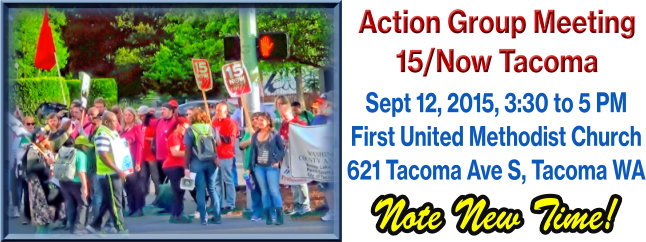
Join 15 Now Tacoma for our weekly action group meeting, September 12, 2015. Learn about Initiative Measure 1, which will be on the ballot in November of 2015. This proposed measure will raise the minimum wage in Tacoma to $15 per hour.
The bosses are fighting this with every tool they can. They will spend millions and try to induce the Mayor and City Council to confuse you with phony alternative measures. Come to our meeting and help us plan our campaign to win this fight.
Child care will be provided at the meeting. Just email us and let us know that you are bringing your child(ren) so that we can be prepared. Contact us for more info: 253-213-7207
To add items to the agenda: Please put proposed agenda items in the comment section below. If you don’t see the comment section, please click here and scroll down a bit.
![]()

- Location:
- First United Methodist Church
- 621 Tacoma Ave S,
Rear of building - Date:
- Sept 12, 2015
- Time:
- 3:30 to 5 PM (New Time)

There is doubtless a compelling moral reason to support workers earning more money to take care of their family responsibilities but just how practical is it? A crash course in Microeconomics might be helpful; which I took at UWT. For one thing, there are a certain fixed number of jobs at the prevailing wage rate (job market in equilibrium), and this is taking into account the people who are looking for work and vacancies that have gone unfilled. Imposing a minimum wage rate that is above the prevailing wage rate can result in employers laying off workers or not hiring as many workers at the higher rate. This policy benefits those few workers who are paid the higher wage but at the expense of those who had to be laid off. The most disadvantaged, unproductive workers are the most vulnerable and increasingly likely to be priced out of the job market altogether. In order to survive, employers will have to reduce hours, cut benefits (pensions, health benefits), as well as pass along the increased costs to the consumer.
A better solution might be for an individual employer to pay workers a “living wage” which is in economic terms, an hourly wage rate for a 40-hour work to pay rent or housing for no more than roughly thirty-five percent of the amount earned. If the rent is $210 weekly, this amounts to $840 monthly. $840/0.35= $2,400/160 hrs. = $15/hr. In this example the living wage may very well exceed the minimum wage and it is offered simply as an illustration. The minimum wage might be a good short term remedy to offset higher cost of living expenses but it may not solve the long-term solution of pay inequity; at least not for those who will be the most adversely impacted (economically poor, low-skilled, non-college educated, or workers who do not have vocational/technical school training).
According to the Washington Real Estate Research Institute (WSU) the average price of a 1 bedroom apartment in Tacoma/Pierce County is roughly between $847-853 monthly (assuming it is not a studio). Since this is the case an increase to $15hr would match a “living wage” to that of a “minimum wage” for our city. The question is whether it should be a gradual increase over several years, which seems to be the most practical as opposed to a radical imposition overnight.
REFERENCES
Browning, Edgar K and Zupan, Mark A. Microeconomics: Theory and Applications.
New Jersey: John Wiley & Sons, 2006. Print.
Parkin, Michael. Microeconomics. New York: Pearson Addison-Wesley, 2005. Print.
Mr. Randle,
Please accept my apologies for taking 3 days to approve this comment.
-Editor